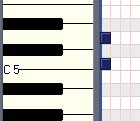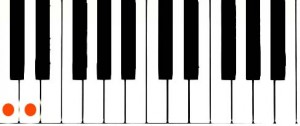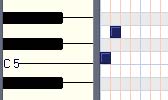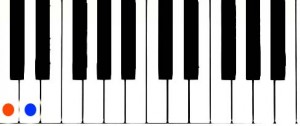In the previous article I stated that in order to understand intervals and their importance we need to listen to them.
In order to create a better feeling for the sound we also need to correlate that with playing.
Below are pictures and tab describing how to play the major 2nd interval on guitar and piano.
——————————————————————————————————-
As usual in the Key of C…
:::Major 2nd:::
Piano Roll View:
Staff View:
Piano: play the two notes together,
Guitar TAB: play the two notes together,
The above examples show the Major 2nd Interval being played together.
Try playing the notes seperately, ie C then E
See below,
Piano roll:
Staff View:
Piano: Play the ‘red dotted’ key first(C) then the ‘blue dotted’ key(D)
Guitar TAB: First note is C Second note is D
—————————————————————————————————————-
Getting to grips with the Major 2nd as with all intervals should be part of your compositional and practical training.
Hearing the difference between a tone and a semitone is also important.
The Major 2nd is probably one that most people find harder to get to grips with when the notes are played together, tones played in this way clash, but sometimes that can be in a good way.
If you flatten the D in the Major 3rd you get a minor 3rd.
Practicing this interval as well will help tune you ears to the semitone.
Always let your ears be the best judge of what sounds good.
Played separately in a melodic sense the two notes close proximity should be listened to carefully.
All melody is built on intervals, listening carefully will help create and also transcribe melody, harmony, riffs and chord structure.
:::End of part 2:::
Working with Intervals (part 3) Major 3rd
Related Articles:
Theory: Working with Intervals (part 1)







